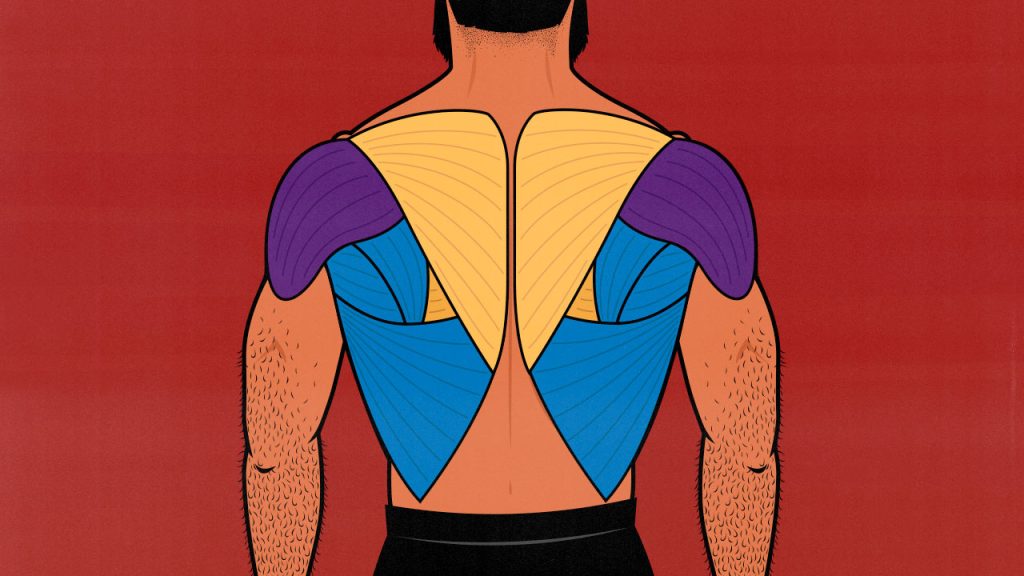
What Muscles Do Pull-Ups Work?
Pull-ups, often conflated with chin-ups, are a compound upper-back exercise. They’ll give you a wide back and thick arms—and we’ll talk about which back muscles they’re best for—but what makes pull-ups even more interesting is how they work muscles you never would have expected.
There are a few interesting things to cover:
- Which back muscles do pull-ups work?
- Are pull-ups good for building bigger biceps?
- Are pull-ups good for building bigger triceps?
- Why are pull-ups so famous for building bigger lower lats?
- How do pull-ups train your abs?
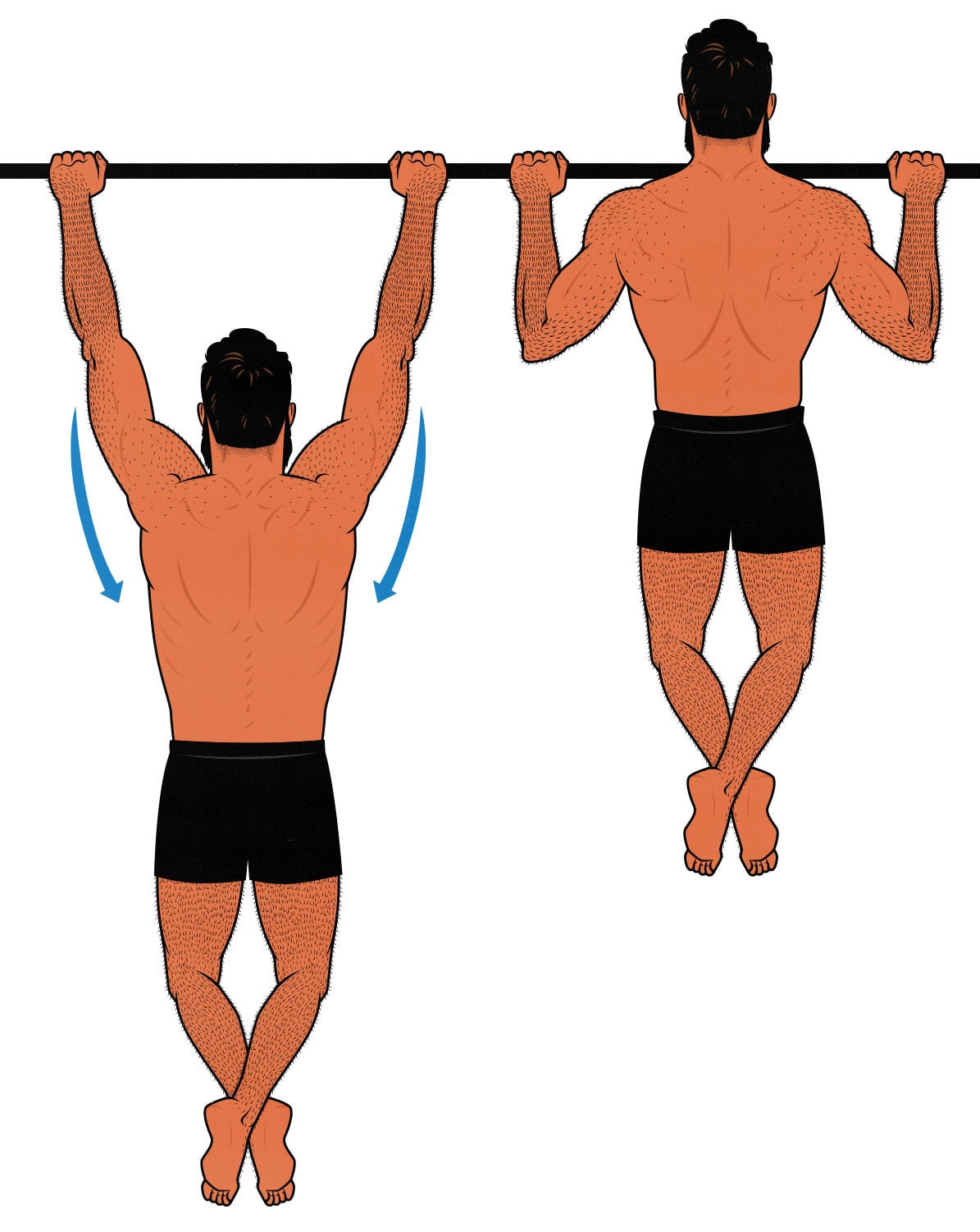
The Main Muscles Worked by Pull-Ups
Pull-ups are famous for helping people bulk up their mid and upper backs, and rightfully so. They do a great job of working your lats, rear delts, rotator cuff, rhomboids, and mid and lower traps. They’re one of the biggest compound lifts for your back, rivalled only by chin-ups, deadlifts, and barbell rows.
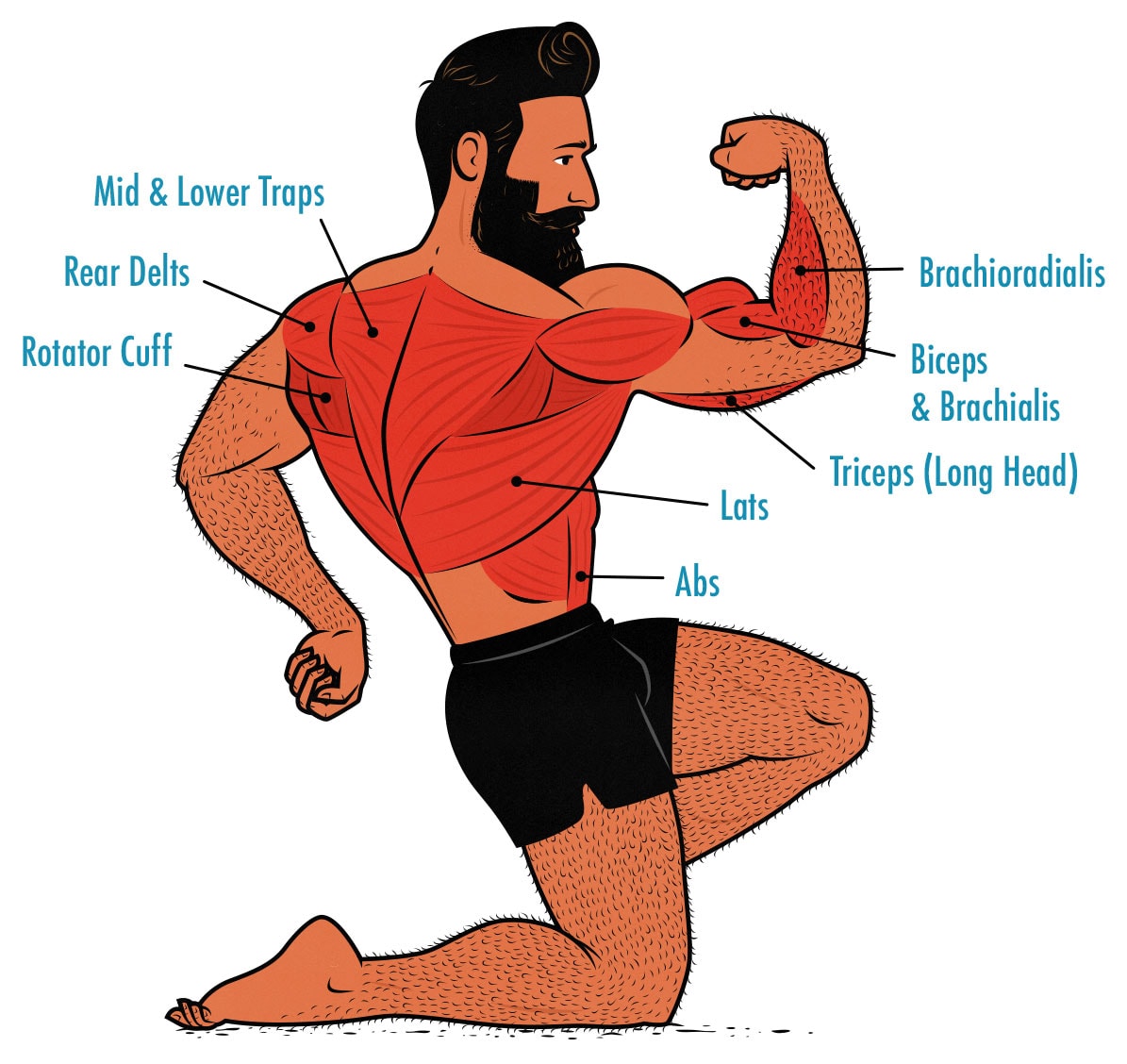
Things get more interesting when we consider the slew of other muscles pull-ups work, such as your grip, your biceps, your triceps, and even your abs. In fact, they’re one of the very best ab exercises. Let’s dive deeper into the details.
How Grip Affects Muscle Engagement
The first thing to know about pull-ups is how they relate to chin-ups. Different people use the terms in different ways, but usually, pull-ups have an overhand grip, whereas chin-ups have an underhand grip.
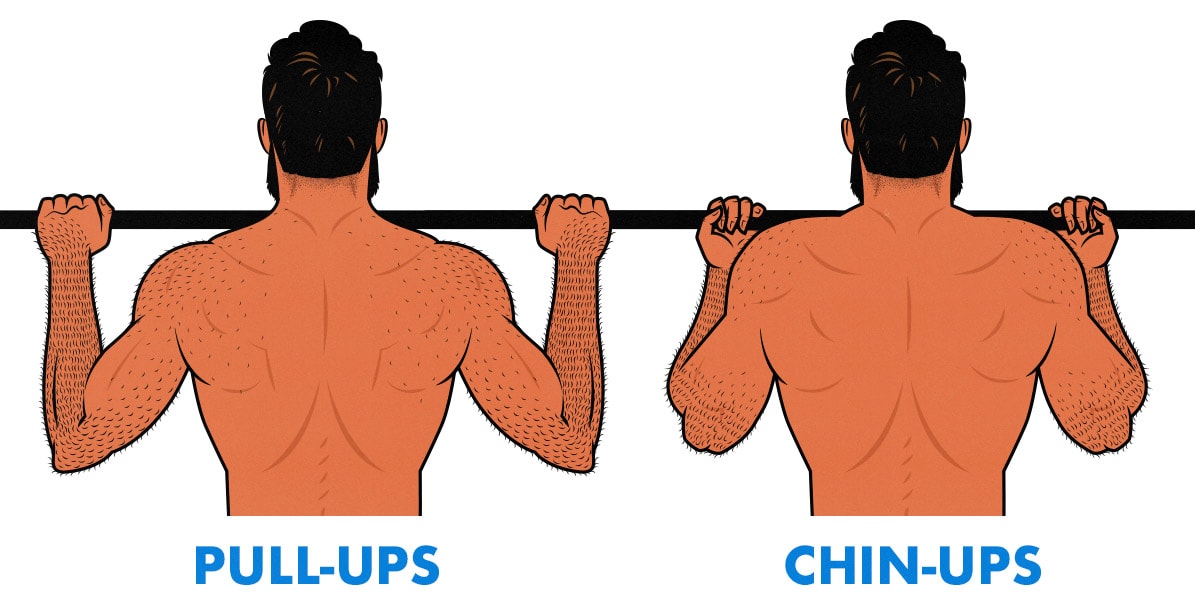
Changing your grip changes which muscles you use to pull yourself up. With a pull-up, your biceps are twisted around the forearm bones, preventing them from getting proper leverage. With a chin-up, your biceps are in a good position to pull, but the movement at the elbow interferes with their activation.
This means that pull-ups force your back muscles to work proportionally harder. Especially your lower lats. This makes them a great back exercise. Not necessarily better than chin-ups, but great nonetheless.
How Well Do Pull-Ups Train Your Biceps?
The conventional wisdom is that pull-ups aren’t very good for building bigger biceps. The argument is that the overhand grip wraps your biceps around your forearms, reducing their leverage. That’s true, but the argument doesn’t quite hold up.
An overhand grip does indeed make your biceps weaker. That’s why pull-ups are harder than chin-ups. However, having bad leverage doesn’t prevent your biceps from fighting to lift you up. In fact, most research shows that your biceps work just as hard with an overhand grip as with an underhand grip (study, study, study). The exception is a study by Youdas and colleagues, finding higher biceps activation while doing chin-ups (study).
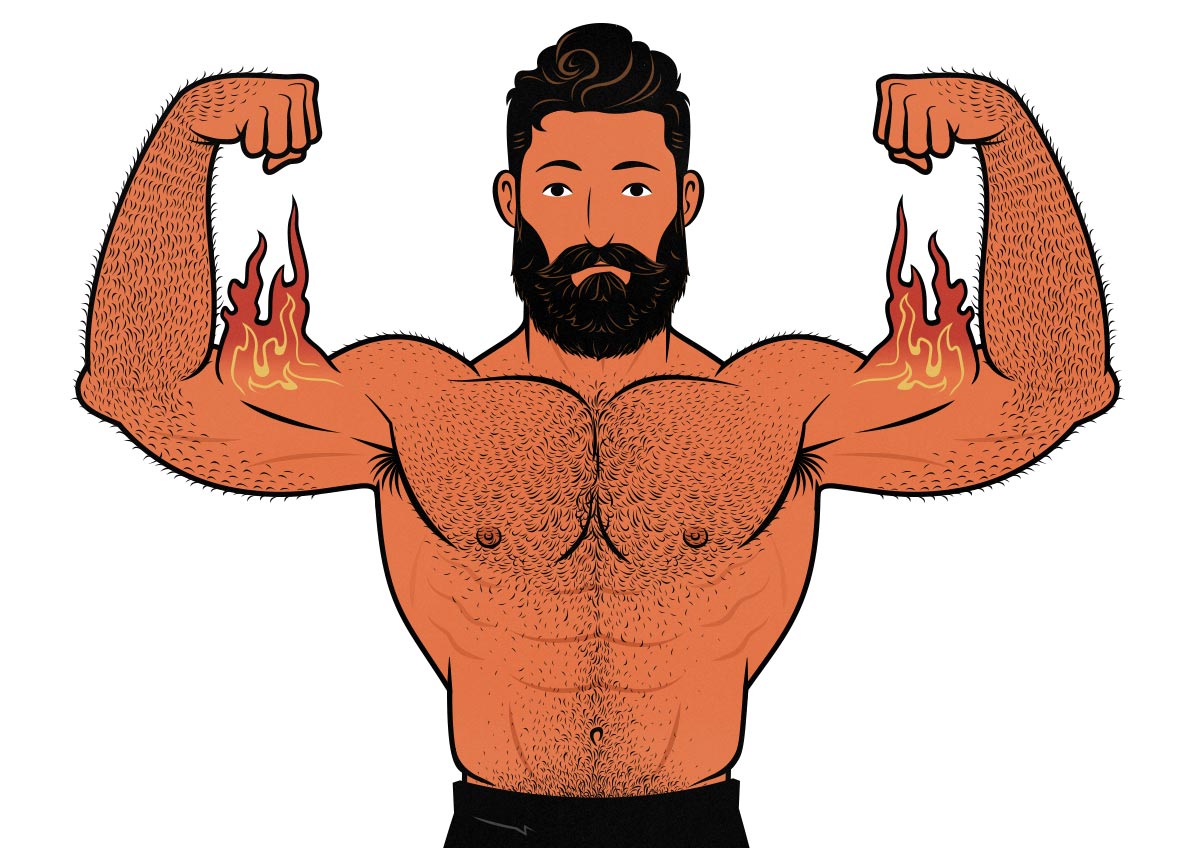
If we look at actual muscle growth, both pull-ups and chin-ups are similarly good at bulking up your biceps (study). On the other hand, bicep curls are about twice as good as any pulling exercise for building bigger biceps (study). So if you want big biceps, do 2–3 sets of curls after your pull-ups.
How Well Do Pull-Ups Work Your Triceps?
You might have noticed that your triceps get sore from doing pull-ups, and that’s totally normal. The long head of the triceps crosses both the elbow and shoulder joints. It can extend the elbows, as in a skull crusher, and it can also extend the shoulders, as in a pullover. That means that when you flex the long head of your triceps, they pull your elbows toward your torso.
If you want to bulk up the long head of your triceps, chin-ups can certainly help, but skull crushers and overhead extensions are better bets. When muscles cross multiple joints, you can usually stimulate about twice as much muscle growth by training them directly. So, once again, if you want bigger triceps, you could do 2–3 sets of tricep extensions after your pull-ups.
Pull-Ups Are Great for Your Lower Lats
Most back exercises start with your elbows in front, and you have to pull them in towards your torso (shoulder extension). Pull-ups do it a little differently. You start with your elbows out to the sides, training shoulder adduction. That’s what your lower lats are for:
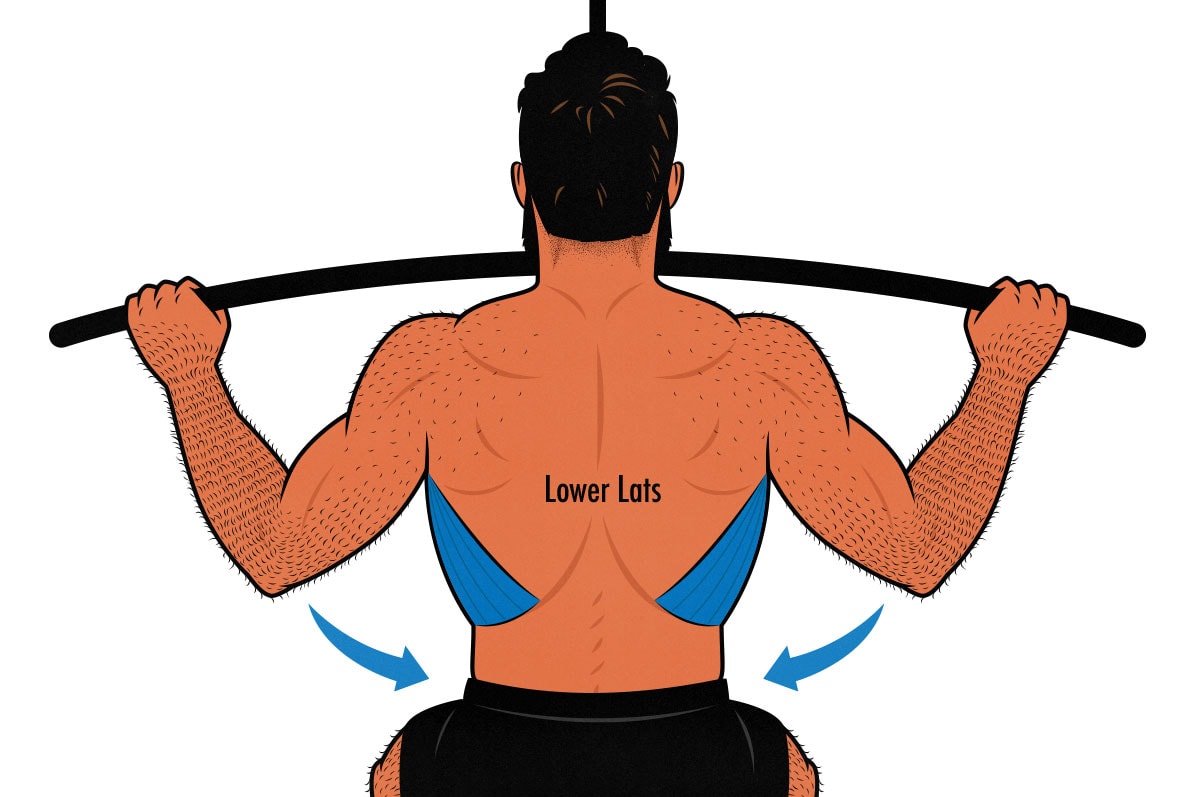
The lower lats are pretty cool. They reach down towards your waist, giving you a v-tapered torso. This makes them highly prized by bodybuilders. Pull-ups and pulldowns are great for training them, earning them a spot in any good muscle-building program.
If you want to know more about how to work all the different muscles in your back, I wrote a big article about back training on Bony to Beastly.
Pull-Ups Train Your Abs Pretty Well
One of the main differences between pull-ups and alternatives like pulldowns is the difference in ab activation. When you’re doing pull-ups, your abs need to work tremendously hard to keep your torso in a stable position. They’re worked even harder as you lower yourself into the bottom position, stretching your abs out.
Your abs won’t be the limiting factor. You won’t stop a set of pull-ups because your abs give out. If your abs are already more than strong enough, they won’t get enough stimulus to grow. That’s why you’ll see some guys lifting their legs up, putting extra tension on their abs. That’s an option when you’re ready for it.
Summary
Pull-ups work almost all of the muscles in your back, with the notable exception of your spinal erectors. That includes your rear delts, rotator cuff, rhomboids, lats, and mid and lower traps. They’re especially prized for working the lower lats, which are hard to stimulate with other back exercises.
Pull-ups also work your biceps, triceps, brachialis, brachioradialis, grip muscles, and abs, to varying degrees. If you care about bulking those muscles up, though, you’ll want to train them directly. If you’ve already bulked those muscles up, pull-ups are enough to maintain them.

Alright, that’s it for now. If you want more muscle-building information, we have a free muscle-building newsletter. If you want a customizable workout program, check out our Outlift Intermediate Bulking Program. We also have our Bony to Beastly (men’s) program and Bony to Bombshell (women’s) program for skinny and skinny-fat beginners.



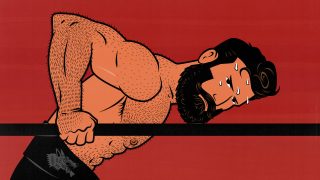


Wow Shane! You are really productive these days. I experienced tendon issues (golfers elbow) after regularly performing chin-ups and pull-ups recently. I had to step down a couple of weeks to improve on my technique. I do not grind reps anymore and therefore do fewer reps with less weight. This helped to fix the issues. Proper technique for the big lifts is extremely important. Especially if you are not twenty anymore.
Thank you, man! I’m trying to grind through some of the simple articles we ought to have on the site. I hope my technique is okay.
I hear you. I’ve had to do that a few times in my own training, most recently with my jogging technique. I had to slow my pace down and reduce my mileage because my shins were taking too much of a beating.
Another good trick for reducing joint strain from chin-ups and pull-ups is to get some gymnastic rings. Your joints can move more comfortably when your hands can freely rotate. Not everyone needs to worry about this stuff, but for those who run into problems, it can be a great remedy.
Keep at it, man!
Good to try something new. In my experience, being a lifter and weighing well above 180 pounds is a real liability for running. I used to do track and field and long distance running on a lower competition level. As I grew stronger and heavier my running performance decreased, though I kept the volume of training the same. By the way, we had a saying at track and field: distance does not kill—speed does.
Ah! I hadn’t heard that saying! I like it. I’ll keep it in mind.
Speed definitely increases impact on the knees and hips—not a great recipe for us mesomorph types! But there is likely a cumulative effect of distance due to repetition even if newtons of force are similar to short sprints spread out over time.
I like low-impact cardio for legs, like a stationary bike (where “sprints” are still possible). Great for HIIT. For the upper body, with boxing, the shoulders take a beating working the heavy bag, but I guess that won’t affect my stride, lol.